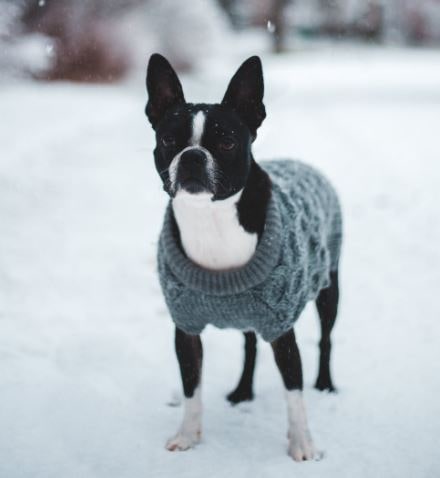Boredom Busters and Play Safety Tips for Dogs
Playing with your pet, both old and young, is a great way to fight boredom and exercise their bodies and brains. It’s a time that you can introduce them to different situations, sounds, and textures that they may not be used to. In puppies and kittens, playtime is a great time to develop muscles, coordination, and trust. And in seniors, it’s an excellent way to keep their brain active and alert.
Tips for successful play time:
- Make sure the environment is free of distractions and supports your pet paying attention to commands so they can successfully complete the task
- Make commands simple and achievable, building up to harder activities
- Encourage and Praise. Do not scold during play unless your pet is doing an undesirable behavior like biting, or going to the bathroom on the floor, etc.
- Take breaks
- Use toys and treats as motivation and attention grabbers
Here are a few ideas for brain games that you can play with your dog.
1. Box of Fun
If you have a large box on hand, place blankets or pet bedding inside the box. Show a toy or treat to your pet, then hide the treats or toy inside the box underneath the blankets or bedding. Your pet will enjoy the challenge of trying to find their toy or treat in this game of hide and seek. Praise your dog when they find the toy.
2. Scoring a Point
At some point in a dog or cat’s life they will be in a crate or kennel whether in your home or at a boarding facility. It can be a helpful step to learn to create a positive and playful association with their crate. When your pet is in a happy mood bring the crate in to the play environment and leave the door open. An open door on a crate makes a great “net” for scoring a goal. In this game, start by picking a toy that will be kept in your pet’s kennel. Create interest in the toy or treat and play a game of fetch with it, but always have the toy land inside the crate, “scoring a goal”. Your dog will have to go inside the crate and come out. By doing this repeatedly they will begin to associate their kennel with fun, that going inside is not permanent, and it’s safe. Additionally, making use of toys, like Kongs that allow you to place peanut butter or treats inside the toy, can help your pet learn to stay longer in the crate. You can also play a similar game of hide and seek with bedding and a reward as mentioned above in #1.
3. Spin-Spin
Learning to spin on cue is a simple game that most puppies will pick up quickly. This can have the added benefit of training them to spin on a towel to dry their feet when they come in from outside. To begin this brain challenge, hold a treat in front of your puppy and make sure that they are aware it’s there. Very slowly move your hand around their side, either right or left, so that they begin to turn to follow the treat, and praise them as they move. Continue until your puppy has moved in a complete circle, and then give the puppy the treat and praise them. If your puppy loses the scent of the treat before they complete the circle, simply begin again and move a little slower until they can build up to a complete circle. Add your cue word at the beginning of the game such as “Spin Spin”. To add an extra challenge, you can play this going in the opposite direction.
4. Search and Rescue
For this game you will need several containers to hide a treat under; for example, flower pots, or Tupperware containers, etc. With this game your pet will learn the importance of paying attention.
Ask your puppy to sit and stay, or have a family member sit on the floor and hold them. Place three containers a short distance away, show your pet the treat or toy, and then place it under one of the containers. Pause, waiting for your pet to look directly at you, and then point to the container under which you’ve placed the treat just as the pet is released to search for it. Repeat the game, switching which container the treat is placed under. You can introduce your verbal cue when it’s time to search such as, “Go find it”. Praise your pet when they find it.
5. Make mealtime a game
Food maze bowls offer your speedy eaters and bored pets a chance to play a mind challenging game while eating their meal. As the food is placed in the maze bowl, it requires the dog to think, lick, and move the kibble to get the food out, providing a fun, challenging activity for dogs at feeding time. This can be done inside or outside. You can buy these bowls here:
6. Go to a Dog Park
A dog park can be a wonderful place for a dog! The open area not only offers the chance to get rid of some of that pent-up energy, but it can also help to improve a pup’s social skills.
Safety is important when bringing any size or age animal to a dog park, especially if the park is to be enjoyed by animals off-leash. Look around for the following:
- Posted rules of conduct
- Secure fencing
- Double-gated entry
- Separate play areas for both large and small dogs
- Trash cans and poop-bag dispensers
- Clean grounds that are free of tall grass, weeds, trash, and dog waste
- Sheltered areas
- Water fountains that are working, clean, and dog-friendly
- Number of dogs within the park area and behavioral characteristics of the animals
- Dog owner attentiveness to activities and animal behaviors from within the park area.
A word about treats as a reward for play:
#1. A general rule of thumb is treats should not account for more than 10% of your kitten’s or puppies’ calories a day, so it’s important to offer treats that are low in calories, since training often leads to multiple treats a day. Also, the calories in treats can make your puppy less hungry for their well-balanced nutrition offered at meal time.
#2. As the veterinarian at VetApprovedRx, I recommend treats that offer well-balanced nutrition with very few ingredients and no fillers, treats that might more closely resemble a high-quality puppy food. I feel confident that all of the treats we offer are safe and healthy for your dog or cat of any age.
A low calorie treat made from real chicken is Lean Treats, and you can purchase these here:
http://vetapprovedrx.pharmacy/lean-treats-for-dogs.html
A word about toys:
It’s best to purchase toys that are durable and made of material that is not toxic, that don’t have multiple tiny parts that can be chewed off and become choke hazards. There are many toys on the market that are made specifically for dogs and cats and are safe to use during play time.
A word of caution on older pets and puppies:
There are many positive implications of playing games with your pet; however, I advise some caution with senior pets and puppies and games that require them to jump from high surfaces, or require repeated impact on joints.
For senior pets, these games can cause pain and damage to already stressed limbs and joints. While your puppy is growing, their “growth plates” at the ends of their bones are soft, and harden once they are done growing. This growth plate area can be susceptible to damage through excessive impact. For both senior dogs and young puppies, hard exercise is not advised. There are a wide variety of games that will challenge your pet with varying degrees of difficulty. I recommend doing some research on brain stimulating games for your pet. Again, the more positive use of your pet’s energy, the less time they may spend on negative behaviors.
To Your Pet’s Good Health and Fun!
Dr. Barry
Sources:
Brain Games for Puppies, Claire Arrowsmith. 2014. Firefly Books, New York.
Train Your Puppy Right. The American Kennel Club. 2012. Bow Tie Press. Irvine, California.
http://www.dogingtonpost.com/dog-park-dangers-how-to-avoid-them/
https://www.animalhumanesociety.org/training/you-go-dog-park






